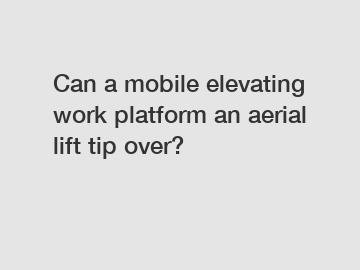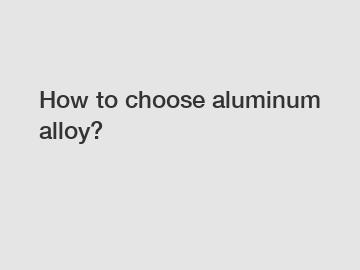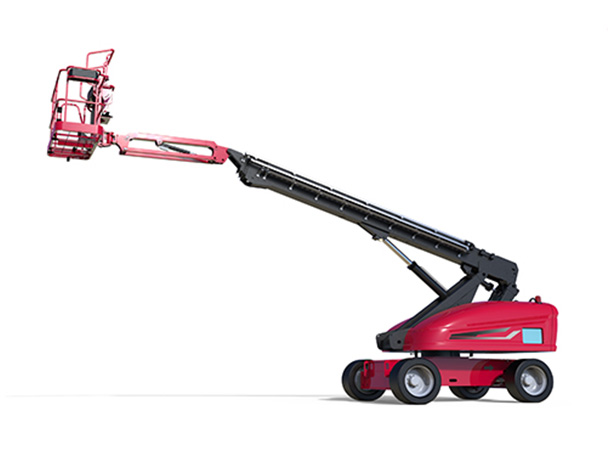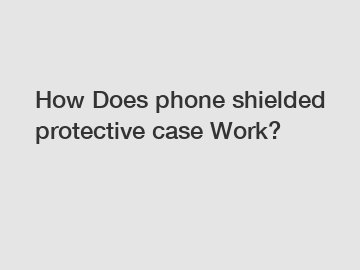Can a mobile elevating work platform an aerial lift tip over?
Feb. 09, 2024
In the modern world of construction and maintenance, mobile elevating work platforms (also known as aerial lifts) have become indispensable tools. These versatile machines enable workers to safely reach heights and carry out tasks efficiently. However, concerns about their stability and the potential for tip-overs often arise. In this blog post, we will discuss the factors influencing the stability of mobile elevating work platforms, debunk common misconceptions, and provide insights into maintaining a safe working environment.
Understanding the Basics:
Mobile elevating work platforms (MEWPs) encompass a variety of aerial lifts such as scissor lifts, boom lifts, and cherry pickers. They are constructed with a robust structure designed to maintain stability under normal operating conditions. These machines are typically equipped with multiple safety features like outriggers, safety interlocks, and tilt sensors to prevent tip-overs.

Factors Influencing Stability:
1. Load Distribution: MEWPs are engineered to accommodate a specific weight capacity. One must be mindful of distributing the load evenly on the platform, as an imbalanced distribution could lead to instability. Workers should follow the recommended guidelines and never exceed the weight limit specified by the manufacturer.
2. Ground Conditions: Uneven or unstable ground poses a significant risk to the stability of any mobile elevating work platform. Before operating, it is vital to assess the terrain for potential hazards such as slopes, soft surfaces, or holes. Stabilizing devices like outriggers or using suitable alternatives can help enhance stability in challenging ground conditions.
3. Environmental Factors: Weather conditions, such as strong winds, can adversely impact the stability of MEWPs. It is crucial to monitor weather forecasts and take appropriate precautions to avoid operating in unfavorable conditions. Wind speed guidelines provided by the manufacturer are critical to ensuring safe operations.
4. Operator Error: A well-trained and vigilant operator is the key to safe MEWP operations. Misjudgment, excessive speed, or improper use of controls can affect stability. Operators should always follow the recommended procedures, maintain clear communication with co-workers, and be aware of potential hazards.
Debunking Myths:
There are common misconceptions surrounding the inherent instability of MEWPs. However, it is crucial to separate facts from fiction to ensure informed decision-making and safety compliance. Let's debunk a couple of myths:
Additional resources:The Versatile Solution: Single Mast Aerial Working Platform
How much does a boom lift cost?
What is an aerial work platform used in construction?
Which Aerial Work Platform Lift is Best for High-rise Maintenance Projects?
What is the cost of a cherry picker?
What are the disadvantages of aluminum alloy?
How does a spider lift work?
1. "MEWPs are inherently unstable." This myth can be attributed to accidents caused by operator error or failure to adhere to safety guidelines. When used correctly and maintained regularly, MEWPs provide a safe working platform.
2. "Large MEWPs are more stable than smaller ones." The stability of a MEWP is not solely dependent on its size. Various factors like load distribution, ground conditions, and operator competency influence stability. All MEWPs must adhere to safety regulations and guidelines regardless of their size.
Maintaining Safety:
To ensure the highest possible level of safety while using MEWPs, here are some best practices:
1. Training: It is paramount that all operators receive comprehensive training from certified instructors. Adequate training enhances operator competency and enables them to recognize potential risks and preventive measures.
2. Regular Maintenance: Scheduled inspections and routine maintenance are essential to identify any wear and tear, malfunctioning components, or structural issues. Sticking to the manufacturer's recommended maintenance plan will help maximize the MEWP's longevity and safety.
3. Risk Assessment: Before operating a MEWP, conduct a thorough risk assessment of the worksite to identify potential hazards. Consider the terrain, overhead obstructions, proximity to power lines, and weather conditions to ensure safe operations.
4. Communication and Collaboration: Establish clear communication channels among the operators and other team members. Regular check-ins, safety briefings, and prompt reporting of any concerns help mitigate potential risks and maintain a safe working environment.
Conclusion:
Mobile elevating work platforms (MEWPs) provide a safe and efficient way to work at heights. By understanding the factors influencing stability, debunking common myths, and following best practices, operators can mitigate the risks associated with tip-overs. Remember, the key to safe MEWP operations lies in proper training, regular maintenance, and a vigilant approach towards safety. Together, we can ensure a secure working environment for all.
The company is the world’s best Portable Aerial Lift, Mobile Aerial Platform Load Capacity Table, Advertising Aerial Working Platform supplier. We are your one-stop shop for all needs. Our staff are highly-specialized and will help you find the product you need.
Additional resources:Mastering Efficiency: Maximizing Track Drive Boom Lift Performance
How do you size a boom lift?
Are self-propelled aerial work platforms worth the investment?
Revolutionizing Work: Self-Propelled Aerial Platforms Explained
What are the top tips for buying Anti Rotation Aerial Work Platforms?
Top 5 Tips for Safely Casing Aerial Work Platform
What is the purpose of the aerial work platform?
145
0
0
Related Articles
-
147
0
0
-
134
0
0
-
120
0
0
-
129
0
0
-
142
0
0
-
10 Questions You Should Know about Wire Plating Machine
Wire plating machines are essential in the manufacturing process of various electrical components.
127
0
0
-
124
0
0
-
139
0
0









Comments
All Comments (0)